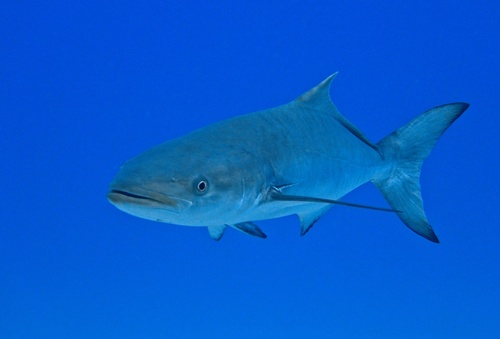
Cobia
The Bluefin Tuna, belonging to the Thunnus genus, encompasses several species renowned for their incredible size, speed, and commercial value. These apex predators play a crucial role in marine ecosystems.
10 15 years
Lifespan
200 cm
Length
Least Concern
Conservation Status
60 km/h
Swimming speed
Carnivorous
Diet
Highly Migratory, Seasonal Migration
Migration
Appearance Overview
The Bluefin Tuna is renowned for its large, streamlined body, built for speed and endurance in the open ocean.
Color
Dark metallic blue on top and silvery-white on the bottom, providing camouflage from above and below.
Fins
Two dorsal fins, the first is depressible, followed by small finlets running towards the tail.
Body Shape
Torpedo-shaped body, designed for efficient swimming.
Length
Up to 10 feet (3 meters), commonly around 6.5 feet (2 meters)
Weight
Up to 1,500 lbs (680 kg), commonly around 550 lbs (250 kg)
Diet
Carnivorous, feeding on a variety of fish, squid, eels, and crustaceans.
Feeding Behavior
Highly active predators, Bluefin Tuna use their speed and agility to hunt, often working cooperatively to herd and capture prey.
Social Behavior
Known to form schools, sometimes segregated by size; they are highly migratory, traveling long distances across oceans.
Commercial Relevance
Extremely high value, particularly in sushi and sashimi markets, where its fatty flesh is considered a delicacy.
Conservation measures
Measures include international fishing quotas, regulations on fishing gear, and efforts to establish marine protected areas.
Status
Varies by species: Atlantic Bluefin Tuna - Endangered; Pacific Bluefin Tuna - Vulnerable; Southern Bluefin Tuna - Critically Endangered.
Threats
Overfishing is the primary threat, driven by high demand for sushi; climate change and habitat degradation also pose significant risks.
Habitat Distribution
Depth Range
Typically found in surface waters to depths of 0-900 meters, but can dive deeper.
Geographic Range
Found in the Atlantic, Pacific, and Indian Oceans, as well as the Mediterranean Sea.
Preferred Environment
Prefers temperate and subtropical waters, often found in open ocean environments.
Reproduction and Life Cycle
Breeding Habits
Spawning typically occurs in warm, specific regions; for example, Atlantic Bluefin Tuna have major spawning grounds in the Mediterranean Sea and the Gulf of Mexico.
Development Stages
Larvae hatch and develop in plankton-rich waters, growing rapidly into juveniles and eventually reaching adult size and maturity.
Fecundity
Females are highly fecund, capable of releasing millions of eggs per spawning season, enhancing their reproductive potential.
Maturity Age
Varies by species, generally reaching sexual maturity between 4-8 years of age.
Faqs about Cobia
How fast can Bluefin Tuna swim?
Bluefin Tuna are among the fastest fish in the ocean, capable of reaching speeds up to 43 mph (70 km/h).
What is the lifespan of a Bluefin Tuna?
They can live up to 40 years, though this varies depending on the specific species and environmental conditions.
Are Bluefin Tuna warm-blooded?
Yes, they are warm-blooded, which allows them to maintain a higher body temperature than the surrounding water, aiding in muscle efficiency.
Why is Bluefin Tuna so expensive?
Bluefin tuna meat is highly prized for its flavor, texture, and high fat content, making it a sought-after ingredient in high-end sushi and sashimi.
What conservation efforts are in place to protect Bluefin Tuna?
Efforts include strict fishing quotas, monitoring of populations, and the establishment of marine protected areas to safeguard breeding grounds.
How far do Bluefin Tuna migrate?
They migrate across vast oceanic distances for feeding and spawning, sometimes traveling thousands of miles.
What are the natural predators of Bluefin Tuna?
Besides humans, their main predators include sharks, orcas, and other large marine species.
What do Bluefin Tuna eat?
They primarily feed on fish, squid, and crustaceans, using their speed to chase down prey.
Copyright @ Nature Style Limited. All Rights Reserved.
 English
English